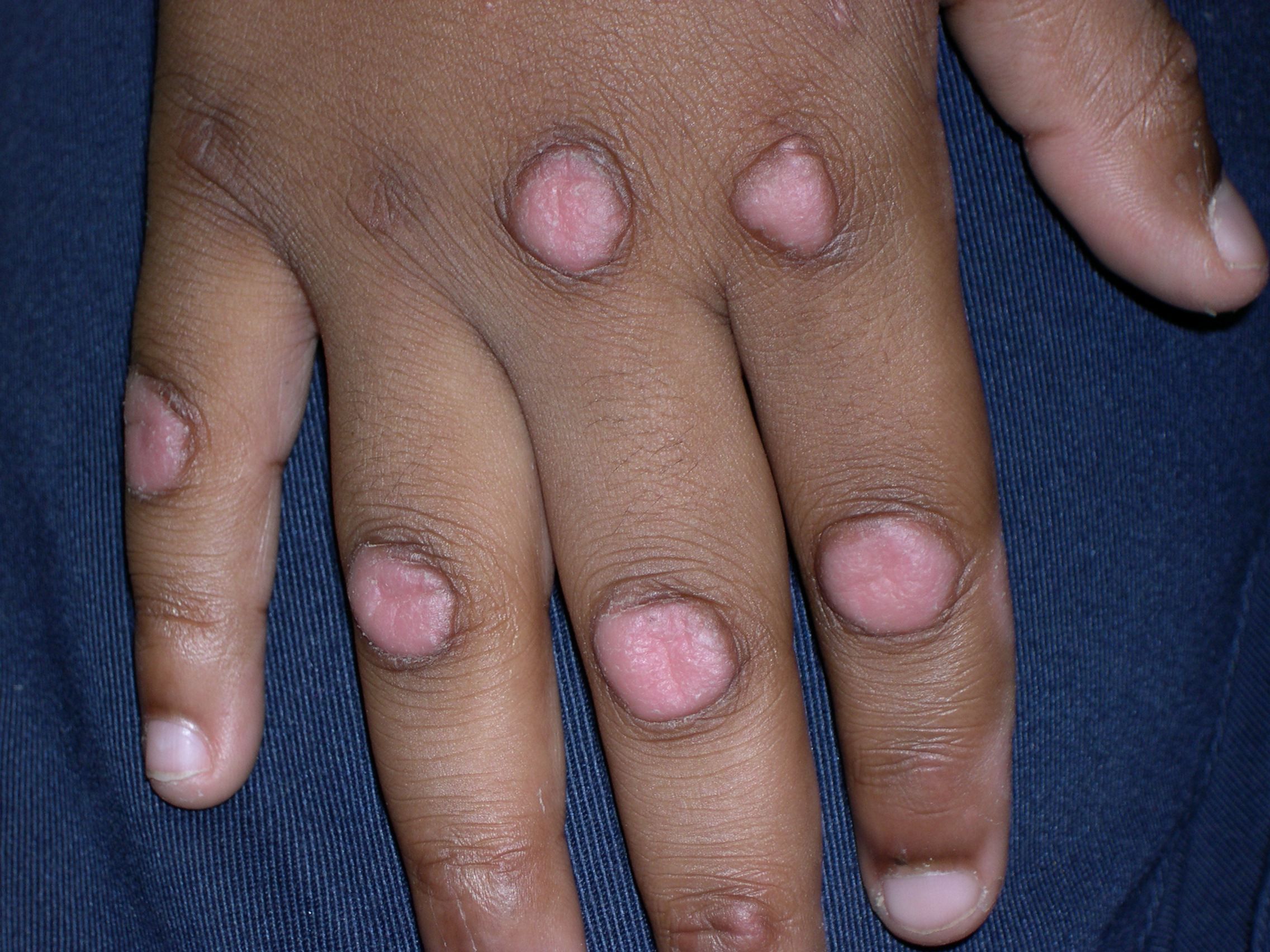Boy’s anxiety leads to hand rubbing, biting
A healthy 11-year-old boy presents for evaluation of thick skin over the metacarpal (MCP) and proximal interphalangeal (PIP) joints on his right hand. What's the diagnosis?
Figure

The case
A healthy 11-year-old boy presents for evaluation of thick skin over the metacarpal (MCP) and proximal interphalangeal (PIP) joints on his right hand (Figure).
Diagnosis: Knuckle pads
Knuckle pads, also called Garrod pads or holoderma, are a type of benign fibromatosis, usually affecting the proximal interphalangeal (PIP) joints of the hands (more often than feet).1,2 They are rarely seen at the metacarpophalangeal or distal interphalangeal joints.
Clinical characteristics
On physical exam, patients usually present with asymmetric, well-circumscribed, smooth to dome-shaped fibrous plaques over joints.1-3 They are more common over the dorsal surfaces of hands, but also can present on feet and knees.1,2 Most patients are asymptomatic, although these plaques may become annoying and pose a cosmetic problem.1
Whereas there usually are no associated arthralgias and range of motion is normal, some patients do have a history of repeated rubbing of the affected skin, as was the case with this patient.1 There also is a positive association with other forms of fibromatosis, ie, palmar (Dupuytren disease) or plantar (Ledderhose disease).1-3 A familial trend of similar ages at presentation has been observed.3 However, the majority of knuckle pad cases appear to be idiopathic.1-3
Although the diagnosis is clinical, further workup has revealed a well-delineated subcutaneous hypoechoic mass without internal flow signals on color Doppler.3 Histologic studies have revealed a proliferation of myofibroblasts with a decrease of elastic filaments in the deep dermis.
Etiology
Knuckle pads may be observed in a variety of inherited disorders. In Bart-Pumphrey syndrome, an autosomal-dominant disorder, patients develop a constellation of symptoms, including knuckle pads, hearing loss, leukonychia, and palmoplantar keratoderma.1-3 Occasionally, epidermolytic palmoplantar keratoderma, which is characterized by thickened skin on palms and soles, also can be present with keratotic lesions on the dorsal surfaces of hands, feet, and elbows.2,3
Secondary causes include trauma or chronic friction, as seen with many surfers and football players due to repetitive friction in sport.1,3 Patients with bulimia also can develop knuckle pads after chronic self-induced emesis.2
Differential diagnoses
Gottron papules, as seen in dermatomyositis, are characterized by multiple nondiscrete, hyperkeratotic, violaceous or erythematous papules or plaques.4 They often present bilaterally along the joints of the dorsal hand, including the MCP, PIP, and distal interphalangeal joints. Cuticular hypertrophy and periungual capillary dilatation also can be visualized with capillaroscopy.
Rheumatoid nodules, an extra-articular cutaneous manifestation of rheumatoid arthritis, are predominantly a late-disease finding in the setting of polyarticular disease.5 They are usually skin-colored, firm, painless subcutaneous nodules that vary widely in size and number on or near affected joints of extensor surfaces.2,3,5
Subcutaneous granuloma annulare most often presents as asymptomatic, deep dermal or subcutaneous nodules on the pretibial area of the legs.6 The scalp, periorbital area, and elbows also may be affected.
Calluses (tylomas) develop under chronic friction and pressure and result in painless, hyperkeratotic areas of skin.
Management
Regression is possible if repetitive behaviors are avoided.1,2 For treatment, apply emollients for dryness and itchiness. If possible avoid aggressive treatments such as surgery because of the increased risk of keloid development.2
Patient outcome
The patient in this case admitted to frequent knuckle rubbing and biting to alleviate his anxiety. The clinicians recommended the application of emollients and behavioral feedback management.
References:
1. Cunliffe T. Knuckle pads. Primary Care Dermatology Society (PCDS) website. Published May 5, 2018. Updated March 24, 2020. Accessed March 31, 2020. http://www.pcds.org.uk/clinical-guidance/knuckle-pads
2. Dyall-Smith D. Knuckle pad. DermNet NZ web site. Published 2012. Accessed March 31, 2020. https://dermnetnz.org/topics/knuckle-pads/
3. Tamborrini G, Gengenbacher M, Bianchi S. Knuckle pads-a rare finding. J Ultrason. 2012;12(51):493-498.
4. Garcia-Cruz A, Garcia-Doval I. Images in clinical medicine. Gottron's papules and dermatomyositis. N Engl J Med. 2010;363(12):e17.
5. Cojocaru M, Cojocaru IM, Silosi I, Vrabie CD, Tanasescu R. Extra-articular manifestations in rheumatoid arthritis. Maedica (Buchar), 2010;5(4):286-291.
6. Requena L, Fernández-Figueras MT. Subcutaneous granuloma annulare. Semin Cutan Med Surg. 2007;26(2):96-99.
Recognize & Refer: Hemangiomas in pediatrics
July 17th 2019Contemporary Pediatrics sits down exclusively with Sheila Fallon Friedlander, MD, a professor dermatology and pediatrics, to discuss the one key condition for which she believes community pediatricians should be especially aware-hemangiomas.